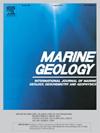The impact of mangroves development and morphodynamics on channel function shift and flow asymmetry in an estuarine channel-shoal system
IF 2.2
3区 地球科学
Q2 GEOSCIENCES, MULTIDISCIPLINARY
引用次数: 0
Abstract
Estuarine channels convey tidal flow and sediments, while the direction and magnitude of tide-residual transports largely depends on the surrounding estuarine bathymetry, shoals and vegetation cover. This study explores the controls of historic morphodynamics, mangrove development and channels on landscape-scale tidal hydrodynamics around a mangrove-covered estuarine shoal in Whitianga estuary, Aotearoa New Zealand. A Delft3D hydrodynamic model was used to explore the impact of historic developments on spatial flow patterns and flow asymmetry based on an analysis of historical images of the site including conditions of the mangrove forest in the 1940s.
Model results clearly reveal areas of ebb and flood dominance in the model domain, where mangrove surrounded creeks are ebb dominant and shoal incising channels are flood dominant. Within the forest, the seaward part of mangroves is ebb-dominant, whereas a flood-dominance function in the back of the forest with higher elevated mangroves is mostly observed. Removing vegetation leads to a large-scale change in flow routing and flow asymmetry, whereas if creeks are infilled, local changes only around the location of the creeks are observed.
The movement of fine sediment fractions is inferred by the slack water duration at high tide. The existence of vegetation affects the cohesive fraction. Without vegetation, the slack water duration becomes shorter on the shoal close to the fringe, inside and the edge of the former forest while it becomes longer inside the river channel and on the edge of the shoal close to the river channel. In the scenario that channels were infilled, a longer (shorter) slack water duration at the mouth and head of channels and inside channels (around the channels) were observed.
Expansion of mangroves can cause a function shift of the channels. Model results suggest that the ebb-dominant modern-day mangrove creek was flood-dominant in 1940s prior to colonization of mangroves in the inner bend of the shoal.
红树林发育和形态动力学对河口河道-浅滩系统河道功能转移和水流不对称的影响
河口河道输送潮汐流和沉积物,而潮余输运的方向和大小在很大程度上取决于河口周围的水深、浅滩和植被覆盖情况。本研究探讨了历史形态动力学、红树林发育和河道对新西兰怀特安加河口红树林覆盖浅滩景观尺度潮汐水动力学的控制作用。通过分析该遗址的历史图像,包括20世纪40年代红树林的情况,使用Delft3D水动力模型来探索历史发展对空间流动模式和流动不对称性的影响。模型结果清楚地揭示了模型域中以退潮和洪水为主的区域,其中红树林环绕的小溪以退潮为主,浅滩切入的河道以洪水为主。在森林内,红树林的临海部分以退潮为主,而在森林后部以较高的红树林为主,主要观察到洪水优势功能。去除植被会导致水流路径和水流不对称的大规模变化,而如果填充溪流,则只会观察到溪流周围的局部变化。细粒泥沙的运动由涨潮时的淡水持续时间来推断。植被的存在影响黏结分数。在无植被的情况下,靠近原森林边缘、内部和边缘的浅滩淡水持续时间变短,而靠近河道的浅滩内部和浅滩边缘的淡水持续时间变长。在河道被填满的情况下,河道口、河口和河道内(河道周围)的松弛水持续时间更长(更短)。红树林的扩张会引起河道的功能转移。模型结果表明,在20世纪40年代,在浅滩内弯的红树林殖民化之前,以退潮为主的现代红树林小溪是洪水为主的。
本文章由计算机程序翻译,如有差异,请以英文原文为准。
求助全文
约1分钟内获得全文
求助全文
来源期刊

Marine Geology
地学-地球科学综合
CiteScore
6.10
自引率
6.90%
发文量
175
审稿时长
21.9 weeks
期刊介绍:
Marine Geology is the premier international journal on marine geological processes in the broadest sense. We seek papers that are comprehensive, interdisciplinary and synthetic that will be lasting contributions to the field. Although most papers are based on regional studies, they must demonstrate new findings of international significance. We accept papers on subjects as diverse as seafloor hydrothermal systems, beach dynamics, early diagenesis, microbiological studies in sediments, palaeoclimate studies and geophysical studies of the seabed. We encourage papers that address emerging new fields, for example the influence of anthropogenic processes on coastal/marine geology and coastal/marine geoarchaeology. We insist that the papers are concerned with the marine realm and that they deal with geology: with rocks, sediments, and physical and chemical processes affecting them. Papers should address scientific hypotheses: highly descriptive data compilations or papers that deal only with marine management and risk assessment should be submitted to other journals. Papers on laboratory or modelling studies must demonstrate direct relevance to marine processes or deposits. The primary criteria for acceptance of papers is that the science is of high quality, novel, significant, and of broad international interest.
 求助内容:
求助内容: 应助结果提醒方式:
应助结果提醒方式:


